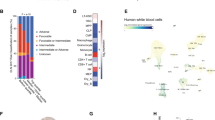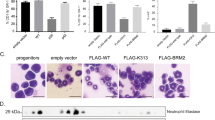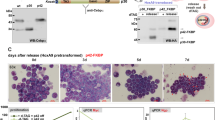Abstract
CBFβ-SMMHC is expressed from the inv(16) chromosome in M4Eo AML. Mice lacking CBF subunits or expressing the CBFβ-SMMHC or AML1-ETO oncoproteins failed to develop definitive hematopoiesis. To investigate these effects on hematopoiesis, we expressed CBFβ-SMMHC from the metallothionein promoter, in both 32D cl3 myeloid cells and Ba/F3 B-lymphoid cells. Addition of zinc increased CBFβ-SMMHC levels more than tenfold, with higher levels evident in Ba/F3 lines. Levels obtained in 32D cl3 cells were similar to those of endogenous CBFβ. Indirect immunofluorescence revealed zinc-inducible speckled, nuclear staining in Ba/F3 cells and diffuse nuclear staining in 32D cl3 cells. CBFβ-SMMHC reduced endogenous CBF DNA-binding fivefold in both cell types, increased cell generation time 1.9-fold, on average, in 32D cl3 cells and 1.5-fold in Ba/F3 cells and decreased tritiated thymidine incorporation into DNA correspondingly. CBFβ-SMMHC increased the proportion of cells in G1 1.7-fold, on average, in 32D cl3 and Ba/F3 cells, and decreased the proportion of cells in S phase by a similar degree. CBFβ-SMMHC induced a marked increase in hypophosphorylated Rb, but did not alter IL-3 Receptor α or β subunit levels. Neither apoptosis nor 32D differentiation was induced by zinc in IL-3 in these lines. Induction of CBFβ-SMMHC in 32D cl3 cells did not inhibit their differentiation to neutrophils or their expression of myeloperoxidase mRNA in G-CSF, and did not produce an eosinophilic phenotype. Additional, proliferative genetic changes in M4eo AMLs might potentiate inhibition of differentiation by CBFβ-SMMHC by allowing its increased expression.
This is a preview of subscription content, access via your institution
Access options
Subscribe to this journal
Receive 50 print issues and online access
$259.00 per year
only $5.18 per issue
Buy this article
- Purchase on Springer Link
- Instant access to full article PDF
Prices may be subject to local taxes which are calculated during checkout
Similar content being viewed by others
Author information
Authors and Affiliations
Rights and permissions
About this article
Cite this article
Cao, W., Britos-Bray, M., Claxton, D. et al. CBFβ-SMMHC, expressed in M4Eo AML, reduced CBF DNA-binding and inhibited the G1 to S cell cycle transition at the restriction point in myeloid and lymphoid cells. Oncogene 15, 1315–1327 (1997). https://doi.org/10.1038/sj.onc.1201305
Received:
Revised:
Accepted:
Issue Date:
DOI: https://doi.org/10.1038/sj.onc.1201305
Keywords
This article is cited by
-
Integrative analysis of RUNX1 downstream pathways and target genes
BMC Genomics (2008)
-
C/EBPα:AP-1 leucine zipper heterodimers bind novel DNA elements, activate the PU.1 promoter and direct monocyte lineage commitment more potently than C/EBPα homodimers or AP-1
Oncogene (2008)
-
Identification of a region on the outer surface of the CBFβ-SMMHC myeloid oncoprotein assembly competence domain critical for multimerization
Oncogene (2006)
-
CBFβ-SMMHC slows proliferation of primary murine and human myeloid progenitors
Leukemia (2005)
-
Mechanism of leukemogenesis by the inv(16) chimeric gene CBFB/PEBP2B-MHY11
Oncogene (2004)



